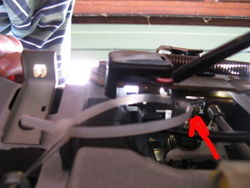Trunk: Install Release Solenoid
This tutorial will show you how to install an aftermarket, powered release solenoid that will allow you to use a remote unit to pop the trunk/rear hatch. These instructions were performed on a 1991 Mitsubishi 3000GT VR4, so I can not guarantee that they will transfer over exactly to any other year, however I see no reason why they shouldn't work with any year 3000GT/Stealth as the solenoid does not rely on any factory wiring.
Disclaimer: I am in no way responsible if you hurt your car and/or yourself in any way while following these instructions.
Parts Required[edit]
- Trunk Release Solenoid
I used a VPA Heavy Duty Power Trunk/Hatch/Door Latch Release Kit Solenoid (Summit Racing Part #VIA-80138). - 12 Volt Relay w/ Wiring Sockets
I used a VPA SPDT Relay (Summit Racing Part #VIA-80237). The relay you pick must be capable of carrying at least 20 amps.
Install a Trunk Release Solenoid in a Mitsubishi 3000GT/GTO and Dodge Stealth[edit]
Prepare Car & Mount Brackets[edit]
- Disconnect the battery.
- Build a metal bracket to support the solenoid. You can use an angle bar, which can be purchased cheaply from most home improvement stores. Using the photo below as a guide, you will see the silverish metal bar that connects under the two factory screws with arrows pointing to them. This bracket will be used to support the back of the release solenoid.
- Install the gold mounting bar that came with the VPA Solenoid Kit. If you're using a different kit, you should be able to create an additional angle bar as you did in step #2. This gold bar connects to the bracket you just made. You'll connect the other end of the gold bar to an unused hole in the trunk. Sorry, but I do not have any pictures of the hole that the other end connects to, but it should be pretty obvious when you see it for yourself. It's the only open place in the general vicinity of where the bar is pointing in the picture below. Please keep in mind that you need to keep the bar low enough that the light bulb can be removed (in case you ever need to replace it). You will not want to have to remove this kit just to replace a light bulb, and while it may be tight, my setup shown below will still allow you to access it.
Install Trunk Release Solenoid[edit]
- Connect the release solenoid to the gold bar. Thread the 2 bolts that come with solenoid (which should already be mounted in its bracket) into the gold bracket to secure the solenoid.
- Route the solenoid's cable towards the trunk latch. Reroute the cable that the solenoid pulls on over towards the trunk latch. You can see in the picture where I have the cable coming back out from behind the back metal plate of the trunk.
- Connect the solenoid's cable to the trunk latch release assembly. You must attach the cable to something that does not conduct electricity and is not the release lever itself. The release solenoid uses this cable as a constant ground, so if you attach it directly to the trunk release lever, your trunk light will stay continuously lit. On my install, I used a heavy duty zip tie, but anything that's fairly strong and will not conduct will work fine. The pictures below shows the lever I chose to pull on and how I routed the cable:
-
Wire up the Trunk Release Solenoid & Relay[edit]
12 Volt Relay Wiring[edit]
Wire up the relay. A standard single-pole relay should have 5 basic pins. Pin #85 and #86 connect to either side of the coil. Pin #30 is connected to 87a when the relay does not have power and 87 when the relay does have power. These wiring instructions are only for devices that supply a ground when a button is pressed (this is by far the most common I've seen, but is not necessarily guaranteed).
| Pin # | Connection Description |
|---|---|
| 85 | Connect to a constant 12 volt source. |
| 86 | Connect to the ground wire from your remote unit. |
| 30 | Connect to a constant 12 volt source that can supply at least 20 amps of current. |
| 87 | Connect to one of the pins on the back of the solenoid. It does not matter which pin as either one will work as long as you don't connect them both. |
Trunk Release Solenoid Wiring[edit]
One of the terminals on the back of the solenoid must be connected to pin 87 on the relay and the other must be connected to ground. It does not matter which one is connected to which pin, but insure that you do not connect both pins to either power are ground.
Route Wires through Cabin[edit]
The green wire is the 12 volt supply and the black wire is the ground trigger wire from my remote unit.
Gallery of Completed Trunk Release Solenoid Install[edit]
This article was originally written by andyvr4.














